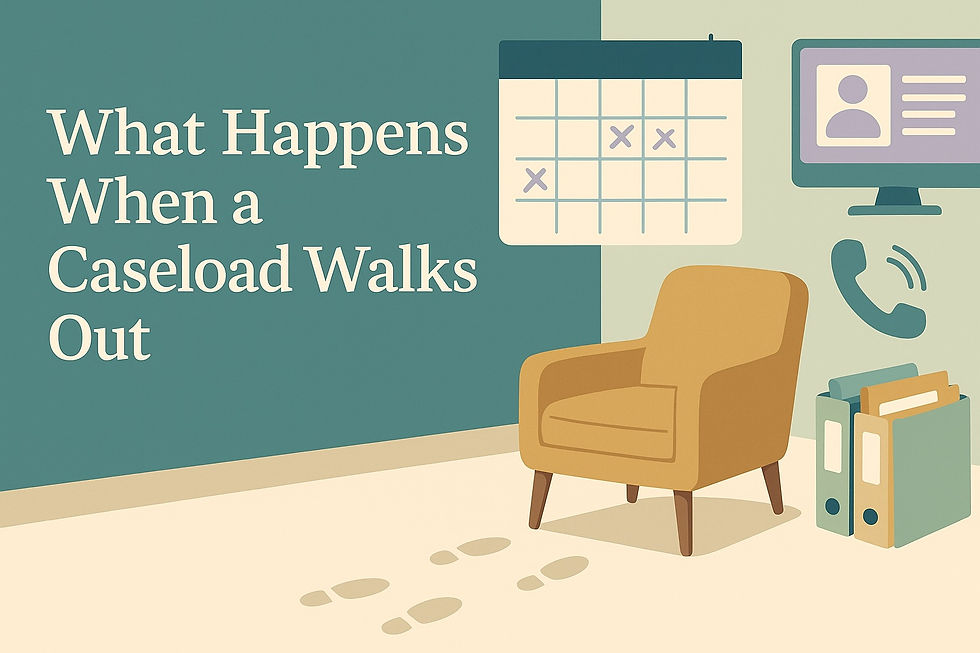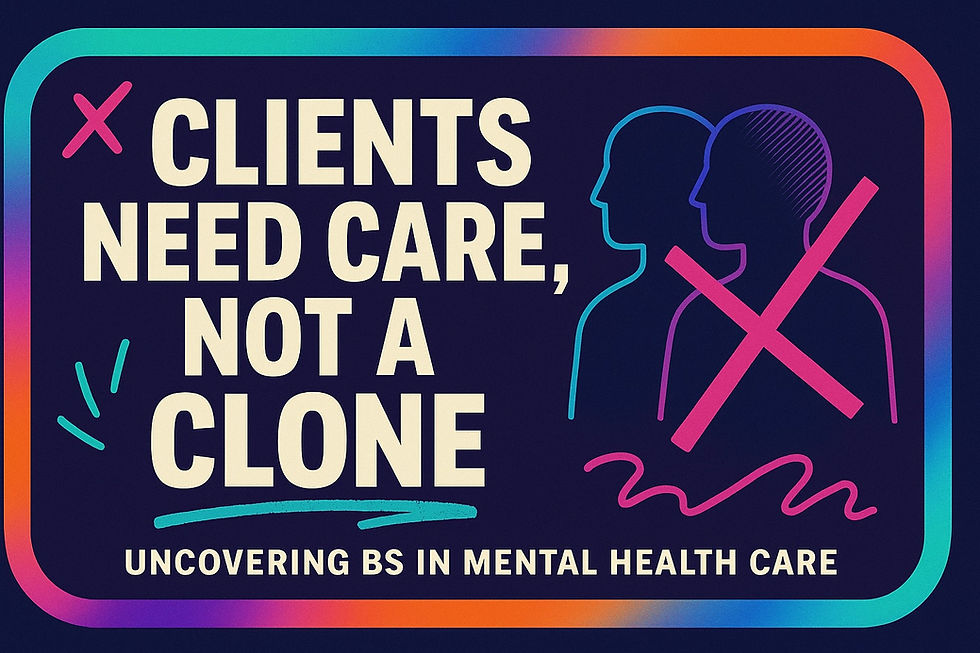What Happens When a Caseload Walks Out
- Cindy Pilcher, MS, LPC, NCC

- Sep 9
- 3 min read

Two real-world shocks, the receipts, and why guardrails aren’t about control—they’re about continuity.
Non-competes get a bad rap. People hear the term and think “control.” From a small practice owner’s seat, they’re more like seatbelts: not the star of the show, but very helpful when there’s a sudden stop. This isn’t about limiting careers—it’s about survival, stability, and fairness so clients keep getting care.
A Quick Reality Check (From My Practice)
Twice, I invested months in credentialing, training, and building a panel with a clinician—only to watch them use that foundation to open their own practice nearby within weeks. No names; details anonymized.
The rhythm was the same:
Friday: resignation.
Weekend: quiet outreach starts.
Monday: cancellations spike, phones light up, admin scrambles, clients are confused.
I don’t fault anyone for wanting independence. But when an active panel is pulled overnight, it’s not “business as usual.” It’s a shockwave.
Protecting the Investment
A full caseload doesn’t happen by magic. Before a counselor ever sees a client, a practice has already poured time and money into:
Recruiting and interviewing
Credentialing and payer enrollment (months of paperwork)
Onboarding, supervision, quality assurance
EHR setup, billing infrastructure, compliance training
Marketing, website, and referral relationships
Translation: real dollars long before the first paycheck. Without any guardrails, someone can leave on Friday and, by Monday, actively pull the clients those investments helped create—leaving the practice with the bill and no revenue to cover it.
Balancing People and Practice
Clients deserve consistent care. Clinicians deserve mobility. And the practice still has to keep the lights on.
Suppose a counselor departs, and half their panel follows immediately. In that case, the revenue dip is instant, but fixed costs are not: payroll, rent, insurance, EHR, taxes, benefits, supervision—none of that shrinks because the calendar did. A short, reasonable restriction buys time to reassign clients, communicate clearly, and keep the operation steady.
Quick math: 20 sessions/week × $85 collected = $1,700/week. Lose half for ~8 weeks and that’s $6,800 gone—fast. I’ve lived this twice—with much higher numbers. Do the math.
Fairness to the Whole Team
A small clinic is a team sport. When one person’s abrupt exit turns into targeted outreach to an active panel, other clinicians absorb the overflow, admin triages, and waitlists stretch. Narrow guardrails (or, more often, simple non-solicitation and confidentiality) keep the playing field fair for those who stay and continue to show up for clients.
Building a Path Forward
Thoughtful agreements aren’t forever or everywhere. The practical standard many small practices aim for:
Short in time (months, not years)
Local in scope (tied to the real service area, not the whole state)
Focused on purpose (protect client goodwill, privacy, and continuity—not block a career move)
It’s a pause button, not a stop sign. Counselors can work elsewhere, specialize, teach, consult—just not actively pull a fresh panel from the place that’s still responsible for coverage.
The Bigger Picture
Running a practice isn’t just therapy hours. It’s salaries, health insurance, technology, compliance, audits, supervision, and all the unglamorous things that keep care accessible. Guardrails are one of the few tools small businesses have to protect the mission—so the phones get answered, the portal works, and clients aren’t stranded mid-treatment.
What Non-Competes Aren’t
❌ A claim to “own” clients (clients always choose)
❌ A life sentence (reasonable ones are brief and targeted)
❌ A substitute for good leadership (culture and fairness still matter)
What Often Works Even Better
If “non-compete” makes everyone itchy, many practices rely on lighter tools that still protect care:
Confidentiality: PHI and client lists don’t walk out the door
Short non-solicit: no active outreach to recent clients for a brief window
Patient-first exits: planned notices, clean handoffs, and records coordination
Bottom line: Small practices don’t need heavy-handed rules. We need narrow, time-limited, client-first guardrails that let people move on and keep care steady for the community. That’s not control—it’s continuity.



Very well said! This is a great depiction of what happens “after the fact” when a clinician just “ups and leaves “. It’s not fair to the business owner and it certainly isn’t fair to clients. A business like yours typically doesn’t start with investors. You are your own investor. You invest time, energy and your own money. You make a few bucks, put it right back into the business. You’ve become successful only to have people you put faith and trust in rip it all apart. You pick up the pieces and do it again and yet again.